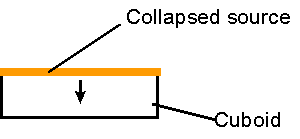IC Packages
Die
Introduction
- Term for the piece of semiconductor on which all the active circuits lie.
- Usually made of Silicon. Gallium Arsenide is used in some special applications (microwave/high speed).
- Circuitry present within a thin layer on one side only, known as active surface.
Figure 4-1.
Basic Structure of a Die
General Thermal Considerations
The semiconductor material of a die has a conductivity approaching that of a metal. If the active layer is assumed to generate constant power per unit area (an assumption that may not always be valid), the die will be practically isothermal.
In practice, applications exist for which the heat flux varies significantly across the die, in which case a temperature gradient may exist on its active surface.
For most packages, the thermal resistance offered by the die is small in comparison with that offered by the rest of the package.
Modeling Options
- Model as a cuboid with temperature dependent conductivity.
- Either
- place collapsed source on active surface to represent heat dissipation, or
- introduce heat within the die cuboid itself. This will assume uniform volumetric heat generation. In most practical situations, both methods will yield similar results.
Figure 4-2.
Representation of a Die
Material Properties
FloTHERM PACK will assume a temperature dependent conductivity valid for silicon. If your die is made of GaAs, or any other semiconductor, then you will need to edit this property in FloTHERM.
Thermal Conductivities:
Silicon: 110 - 150 W/(m.K)
GaAs: 45 - 60 W/(m.K)